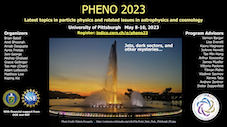Speaker
Description
A new fundamental theory [1] unavoidably predicts supersymmetry, SO(N) grand unification, and a new description of all fundamental scalar bosons. As discussed in our previous papers [2-5] and many recent talks, this last feature in turn unavoidably predicts a dark matter WIMP which is consistent with all experimental and observational constraints, and which should be observable via direct detection (within the next few years), collider detection (within about 15 years), and indirect detection (for which there is already evidence). Here we point out another important consequence: It is not possible to form the usual sfermions described by the 16 of SO(10), and instead it is necessary to form real scalar boson fields with the same basic character as the higgsons of our earlier papers, having no interactions other than (1) second-order gauge couplings and (2) the usual Higgs coupling. This means that the scalar boson partners of fermions will be harder to produce and observe than is currently expected, and the same will be true of gauginos and Higgsinos via processes which also involve scalar boson superpartners. One then has a different version of natural supersymmetry, with superpartners at ~ a few hundred GeV which are more difficult to observe, and which have modified experimental signatures.
[1] Roland E. Allen,"Some unresolved problems from a fresh perspective", arXiv:2302.10241.
[2] Reagan Thornberry et al., EPL [European Physics Letters] 134, 49001 (2021), arXiv:2104.11715 [hep-ph].
[3] Caden LaFontaine et al., Universe 7, 270 (2021), arXiv:2107.14390 [hep-ph].
[4] Bailey Tallman et al., ICHEP-2022 proceedings, arXiv:2210.05380 [hep-ph].
[5] Bailey Tallman et al., Letters in High Energy Physics LHEP-342 (2023), doi.org/10.31526/lhep.2023, arXiv:2210.15019 [hep-ph].
